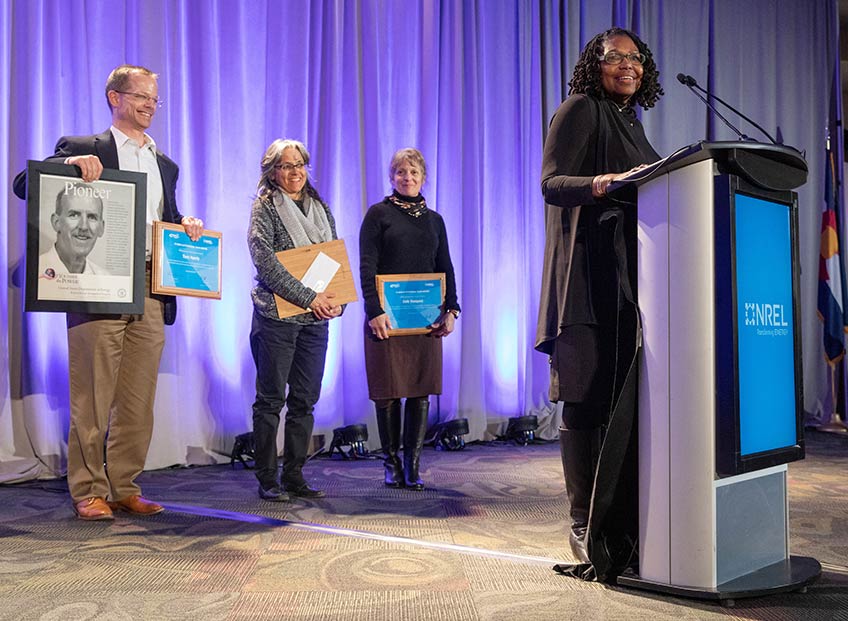NREL Federal Energy Management Program Team Directly Supports $13.7B of Federal Facility Energy Efficiency Improvements

Doug Dahle, Tom Harris, Chandra Shah, Karen Thomas, and Deb Vasquez comprise a special NREL Federal Energy Management Program (FEMP) procurement team responsible for directly supporting almost $14 billion worth of upgrades to federal energy infrastructure projects—an impressive feat that this week earned them an Outstanding Team staff award from NREL leadership.
In many ways, including the use of unique contracting and financing mechanisms, these five individuals—with a total 98 years of dedication to NREL—offer innovative solutions to ensure federal facilities received the energy efficiency and renewable energy upgrades they needed.
This team created a pathway to fund energy efficiency upgrades to federal facilities with private money instead of taxpayer dollars and saved the federal government by leveraging two procurement mechanisms: energy savings performance contracts (ESPCs) and utility energy service contracts (UESCs). Through both methods, either a private company or a utility pays the upfront costs and ultimately the federal government repays by sharing in the resulting cost savings. In the end, the federal government saves money while reducing energy use.
“The FEMP program is a key driver of energy efficiency in federal buildings, and our FEMP Project Development and Finance team (PD&F) is at the heart of NREL’s support of this impressive procurement program,” Adam Warren, NREL Director for the Integrated Applications Center (IAC) said. “The technical and procurement expertise of our FEMP PD&F team have helped our federal partners understand how to leverage private sector financing to deliver impressive results.”
The impact has been well-recorded and has steadily increased over the years. This team guides federal agencies to leverage procurement resources and assistance to spur public-private partnerships and successfully implement replicable, well-designed projects. These efforts have resulted in the federal government achieving a 49% reduction in energy intensity since 1975 and cost savings of approximately $50 billion.
In FY17 alone, the federal government reduced energy in federal buildings by 2% (from FY16), reduced potable water consumption by 3.8% (from FY16), and leveraged $1.145 billion in private sector investments (performance contracts) to drive energy and water savings in federal facilities. It also used renewable energy to power more than 10% of its facility energy needs and increased renewable electricity produced on federal land by 16% (from FY16). The federal government has more than 2,700 sustainable buildings in its portfolio. This steady, annual progress has increased over time and resulted in significant cost and energy savings, and even resulted in increased site resilience before it had a name.
“Doug’s creativity and ingenuity supported broader uses of ESPC through the years, and helped establish the foundation for the entire ESPC industry as it is today,” Karlynn Cory, IAC PD&F Group Manager, said. “Karen is the founding mother of utility energy service contracts…she has conducted training, been a critical problem solver, helped unstick key projects, and supported successful project development and growth for 24 years. Chandra is the FEMP guru on renewable energy procurement, renewable energy certificates, power purchase agreements, and ESPC energy sales agreements; she has supported FEMP for 20 years. Deb brings technical expertise to her projects and she provides technical advice on technology selection, performance assurance, and other technical issues for 17 years. Tom is the relative ‘newcomer’ to the FEMP PD&F team—at only 9 years—and has supported successful ESPCs for a variety of federal agencies.”
Learn more about the Department of Energy’s Office of Energy Efficiency and Renewable Energy.
Last Updated May 28, 2025
